Peanut Storing: Learn About Post Harvest Peanut Curing

One year when my sister and I were children, we decided to grow a peanut plant as a fun -- and from my mother's point of view, educational -- experiment. It was probably my first foray into gardening, and surprisingly, yielded an actual, although extremely unappetizing, peanut crop. Unfortunately, we didn't know that post-harvest peanut curing followed by roasting has to occur before they taste anything like ballpark nuts.
How to Dry Peanut Plants
Peanut curing in gardens doesn't occur directly but only after harvesting. Peanuts, also known as goobers, goober peas, ground peas, ground nuts, and earth nuts, are legumes that uniquely flower above ground but fruit under the soil. Peanuts are categorized by either nut variety (Spanish or Virginia) or by their growth habitat -- either runner or bunch. Virginia peanuts are the type found at baseball parks around the country with one or two large kernels per peanut pod. Spanish peanuts have two or three smaller kernels and are often sold with a rusty red “skin” adhering to the outside of the nut. Both varieties require well-drained soil. They should be planted after the danger of frost has passed, as they call for a soil temperature of 65 F. (18 C.) for germination. Sow the peanut seeds 1-1/2 inches (4 cm.) deep, 6-8 inches (15 to 20.5 cm.) apart. Space bunch types 24 inches (61 cm.) apart and runner peanuts 36 inches (91.5 cm.) apart. These warm-season annuals take a minimum of 120 frost-free days to maturation. The moisture content of a peanut kernel, once dug up, ranges from between 35 to 50 percent. This relatively high moisture content must be properly brought down to 8 to 10 percent through proper post-harvest peanut curing. Improper curing will result in molding and spoilage.
Post Harvesting Peanut Curing
Harvest the peanuts once the foliage yellows in late summer to early fall. Dig the plant up carefully and shake the loose soil from the pods. Curing peanuts may then be accomplished via natural drying or mechanical drying. Commercial farmers use mechanical techniques for curing peanuts, but the home grower can air-dry the nut. You can try peanut curing in garden sheds or garages or in a window indoors so long as they are warm and dry and humidity levels stay low. Hang the plant for one to two weeks in that location. Damp or humid conditions will cause the nuts to rot, while overly hot or rapid drying will lower the quality, giving the peanuts an odd flavor and splitting the shells. Rain during the last days of curing will cause shell discoloration and potential mold and insect infection.
Peanut Storage
Once the nuts are properly cured, peanut storage should occur in mesh bags stored in a cool, well-ventilated area until you choose to roast them. Peanuts do have high oil content, and as such, will eventually go rancid. To lengthen the life of your peanuts, store them in a sealed container in the refrigerator for several months or in the freezer for several years.
Gardening tips, videos, info and more delivered right to your inbox!
Sign up for the Gardening Know How newsletter today and receive a free copy of our e-book "How to Grow Delicious Tomatoes".

Amy Grant has been gardening for 30 years and writing for 15. A professional chef and caterer, Amy's area of expertise is culinary gardening.
-
 8 Perfect Flowers To Plant With Tomatoes To Boost Yields & Banish Pests
8 Perfect Flowers To Plant With Tomatoes To Boost Yields & Banish PestsDon’t forget flowers when choosing companion plants for your tomato beds or pots. These pretty, fragrant blooms add beauty but are also highly beneficial.
By Mary Ellen Ellis
-
 Want The Longest Lasting Hydrangea Flowers? Grow These 8 Panicle Hydrangea Varieties
Want The Longest Lasting Hydrangea Flowers? Grow These 8 Panicle Hydrangea VarietiesFor ornamental shrubs that deliver the longest flowering seasons with plush blooms and delicate hues, these panicle hydrangea varieties are essential in your yard
By Tonya Barnett
-
 Valencia Peanut Info: Learn How To Grow Valencia Peanuts
Valencia Peanut Info: Learn How To Grow Valencia PeanutsIf you are only familiar with peanuts in the form of peanut butter or ballpark snack, you may be wondering what are Valencia peanuts? Click this article to find out how to grow Valencia peanuts and other info on Valencia peanut varieties.
By Amy Grant
-
 Spanish Peanut Information: Tips On Growing Spanish Peanuts In Gardens
Spanish Peanut Information: Tips On Growing Spanish Peanuts In GardensIf you've ever enjoyed peanut candies or peanut butter, then I'm sure you are familiar with their tasty potential and can't wait to get started growing Spanish peanuts in your garden. Let's get talking about Spanish peanut information and find out how to grow Spanish peanuts here.
By Shelley Pierce
-
 Watering Peanut Plants: How And When To Water A Peanut Plant
Watering Peanut Plants: How And When To Water A Peanut PlantHalf the fun of raising peanut plants is watching them grow and change rapidly. But in order to achieve this feat, certain peanut water requirements must be met. So how much water does a peanut plant need? Find out in this article.
By Gardening Know How
-
 What Is A Virginia Peanut: Information On Planting Virginia Peanuts
What Is A Virginia Peanut: Information On Planting Virginia PeanutsAmong their many common names, Virginia peanuts are called goobers, ground nuts and ground peas. Although they're not grown exclusively in Virginia, their common name gives a nod to the warm southeastern climates where they thrive. Learn about them here.
By Victoria Blackstone
-
 Indoor Peanut Growing – Learn How To Grow Peanuts Indoors
Indoor Peanut Growing – Learn How To Grow Peanuts IndoorsCan I grow a peanut plant indoors? This may sound like an odd question to people who live in sunny, warm climates, but for gardeners in chilly climates, the question makes perfect sense! If you want to learn how to grow peanuts indoors, click this article.
By Mary H. Dyer
-
 Runner Type Peanuts – Information About Runner Peanut Plants
Runner Type Peanuts – Information About Runner Peanut PlantsPeanuts are not at the top of the list of the most common plants in the garden, but they should be. They're relatively easy to grow, and there's nothing cooler than curing and shelling your very own peanuts. Learn about runner type peanuts in this article.
By Liz Baessler
-
 Groundcover Peanut Varieties: Using Peanut Plants As Groundcover
Groundcover Peanut Varieties: Using Peanut Plants As GroundcoverIf you are tired of mowing your lawn, take heart. There is a perennial peanut plant that produces no nuts but provides a beautiful lawn alternative. The pretty little yellow flowers are edible and can be used in salads. Learn more about these plants here.
By Bonnie L. Grant
-
 Types Of Peanut Plants: Learn About Different Varieties Of Peanut
Types Of Peanut Plants: Learn About Different Varieties Of PeanutWant to grow peanuts? How hard can it be? After all a peanut is a peanut. But what if your search of peanut plant seeds reveals that there's more variety to peanuts than you knew? Learn about the differences between these peanut plant varieties in this article.
By Darcy Larum